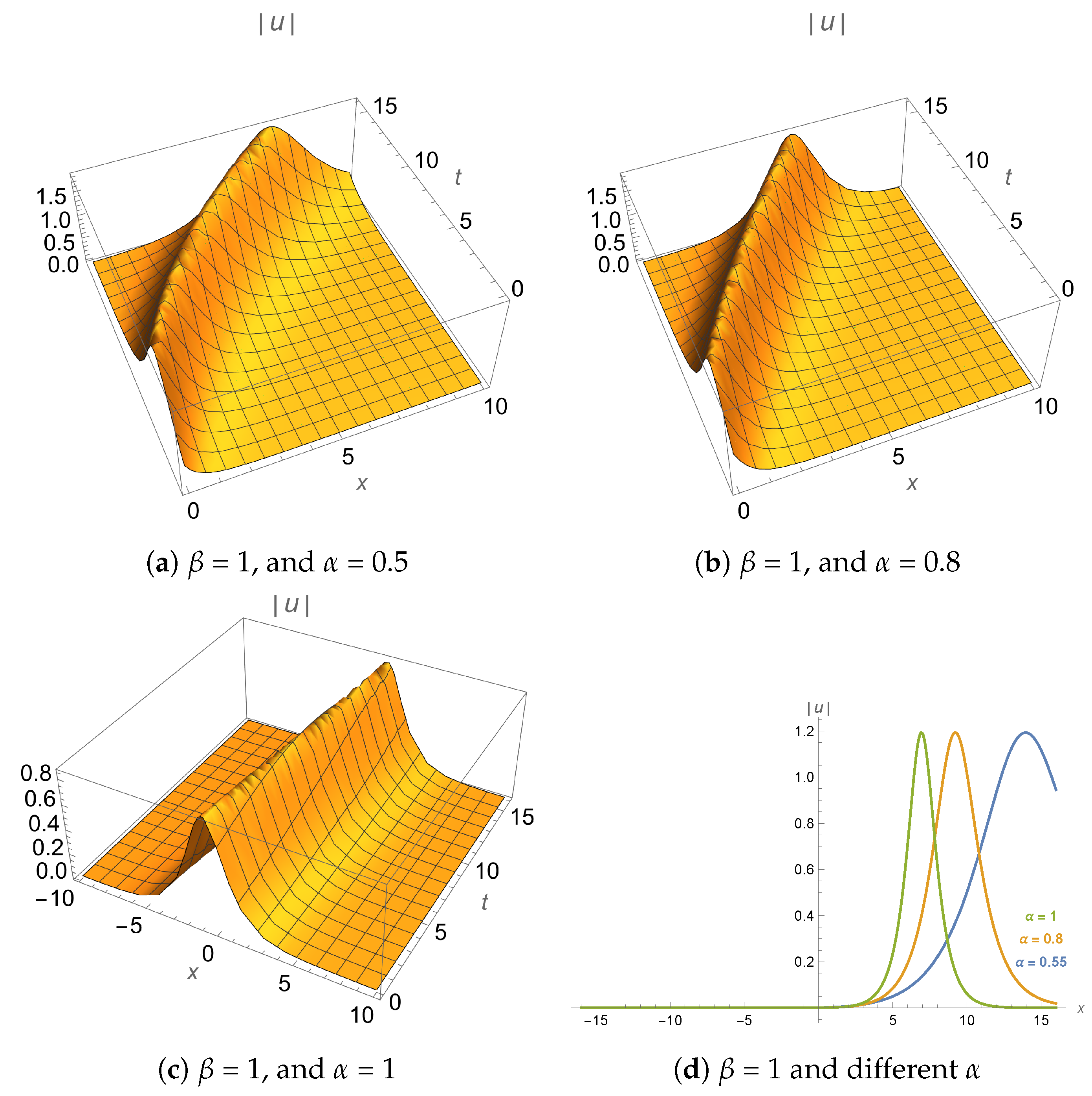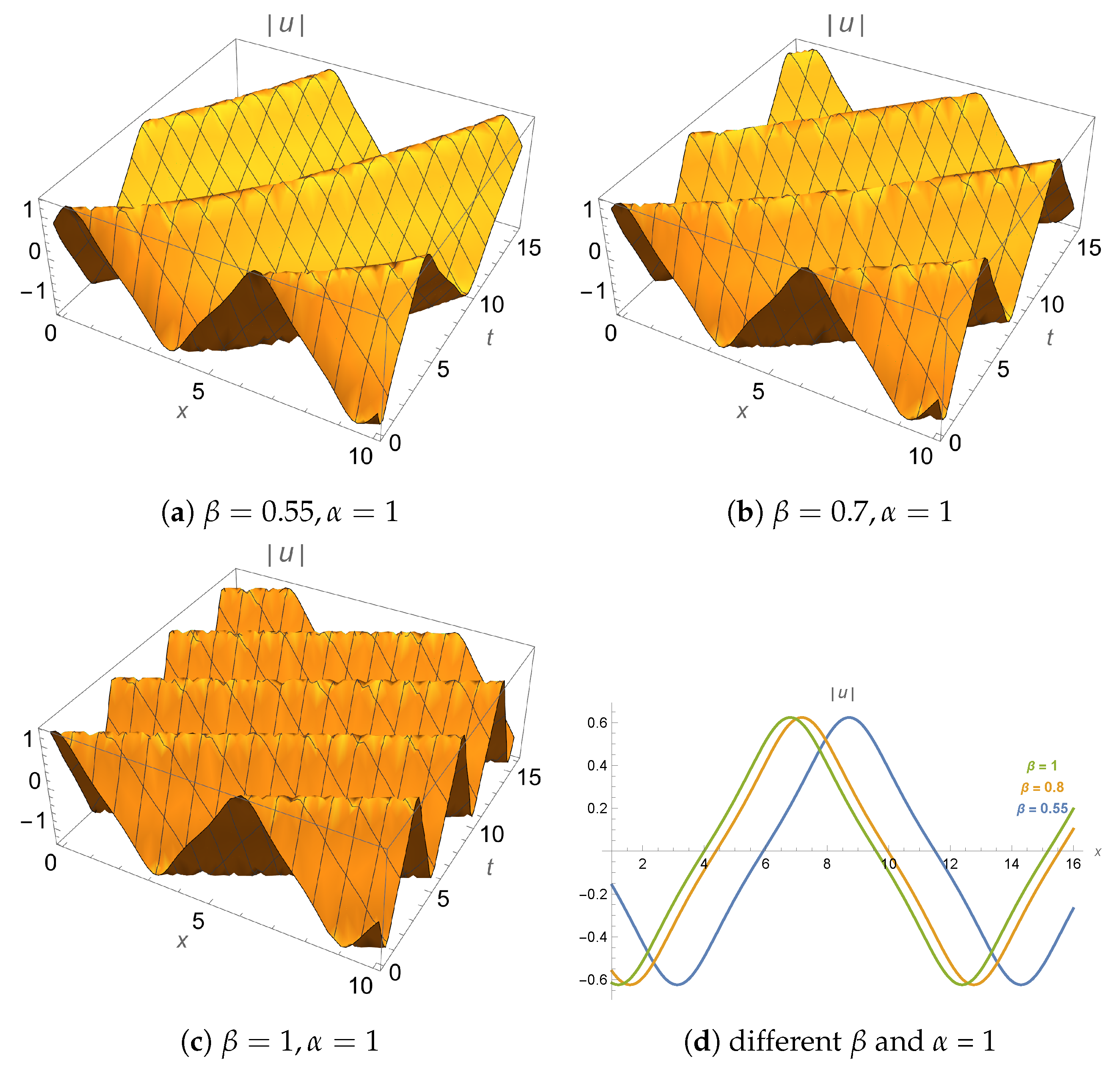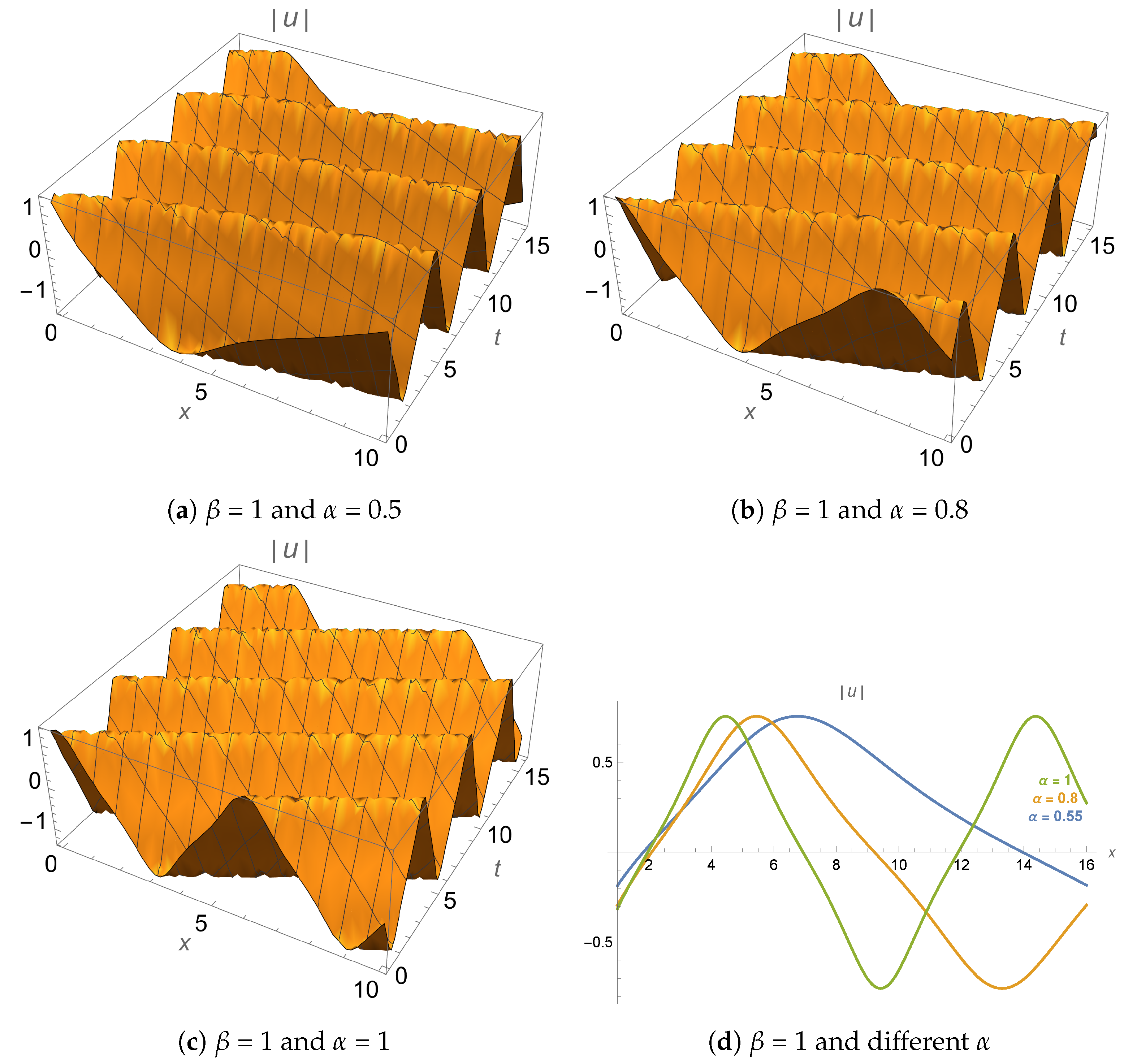Fractional Wave Structures in a Higher-Order Nonlinear Schrödinger Equation with Cubic–Quintic Nonlinearity and β-Fractional Dispersion
Abstract
1. Introduction
- To derive exact analytical solutions to a generalized fractional HNLS model using the IMETM;
- To examine how fractional orders (space) and (time) shape wave propagation dynamics;
- To provide physically meaningful simulations that capture soliton behavior under fractional dispersion.
2. The Proposed Scheme
- Step (1):
- Equation (3) is converted to an ordinary differential equation (ODE) by applying the following wave transformation:
- Step (2):
- Write the converted ODE’s solution aswhere the following DE is satisfied by :
- Step (3):
- The balancing rule is used to calculate the parameter N.
- Step (4):
- Step (5):
- The created system in step 4 is solved using Mathematica software packages V.13.3 to yield and and the parameters h, k, , and .
- Step (6):
- Finally, by assigning distinct numerical values to the parameters , , , , and , various solutions can be derived.
- Case 1:
- Case 2:
- Case 3:
- Case 4:
- Step (7):
- To obtain solutions for Equation (3), add the constants and to Equation (5) in addition to the described general solutions of Equation (6). To elucidate the rationale for selecting the IMETM, it is instructive to compare it with other established analytical techniques, such as Hirota’s bilinear method and the inverse scattering transform (IST). Hirota’s method excels in deriving multi-soliton solutions for integrable NLPDEs by transforming them into bilinear forms, but its applicability is often limited to soliton solutions and integrable systems, which may not fully accommodate the non-local nature of -fractional derivatives in the fractional NLSE. Similarly, the IST provides a rigorous framework for integrable systems, yielding soliton solutions through scattering analysis, yet its computational intensity and complexity make it less practical for non-integrable or fractional systems. In contrast, the IMETM offers distinct strengths: its versatility in generating diverse solution types, including solitons, Jacobi elliptic, Weierstrass elliptic, and exponential functions, enables a broader exploration of the fractional NLSE’s dynamics. Additionally, the IMETM’s straightforward algebraic approach, which reduces the NLPDE to a system of nonlinear equations solvable via software like Mathematica, enhances computational efficiency and accessibility. Its seamless incorporation of fractional derivatives through wave transformation further optimizes its suitability for modeling complex, non-Gaussian wave phenomena, making the IMETM a robust and flexible tool for this study. Despite its strengths, the IMETM has certain limitations. It relies on a predefined functional ansatz—typically involving hyperbolic or elliptic functions—which restricts the class of solutions to those compatible with this structure. As a result, the method may not capture more complex or irregular solution behaviors such as rogue waves, chaotic waveforms, or multi-soliton interactions. Additionally, while the method is well-suited for generating analytical solutions, it is not inherently designed for exploring solution stability or performing long-time dynamics, which may require complementary numerical methods. These constraints should be considered when applying the IMETM to broader classes of fractional nonlinear systems.
3. Applying to the Studied Model
4. Graphical Simulations of Some Obtained Solutions
Physical Relevance of Solutions
- Role of spatial fractional order : The parameter governs the degree of anomalous spatial dispersion. As shown in Figure 2 and Figure 4, decreasing results in broader wave profiles and reduced peak amplitudes, indicating enhanced spatial spreading. This behavior models long-range dispersive effects observed in fiber optics and photonic lattices.
- Role of temporal fractional order : The parameter captures memory effects in the system. As demonstrated in Figure 1 and Figure 3, lower values of result in broader, more diffuse pulse shapes due to enhanced non-Markovian behavior. This is relevant for modeling ultrashort pulse propagation in media with temporal relaxation.
- Interpretation of bright soliton (Equation (12)): The bright soliton represents a localized pulse sustained by the balance between fractional dispersion and cubic–quintic nonlinearity. This is applicable in self-focusing media such as high-power laser systems and nonlinear fibers with tailored dispersion profiles.
- Interpretation of Jacobi elliptic solutions (Equation (14)): These solutions describe periodic waveforms, which may correspond to pulse trains or modulated structures in wavelength-division multiplexing (WDM) systems. The influence of and on wave periodicity and sharpness is consistent with observed dispersion-induced distortions in experimental setups.
- Choice of parameters: The parameters , , , and were chosen to satisfy the solvability conditions of the IMETM. In physical terms, captures self-focusing nonlinearities, and positive reflects higher-order dispersion—a typical combination for modeling soliton propagation in cubic–quintic media. These values align with existing theoretical studies [30,31,32,33] and produce physically realistic waveforms.
- Real-world relevance: The flexibility of fractional orders allows for tailoring the solution behavior to match specific experimental scenarios, such as pulse compression, dispersion management, or long-distance propagation stability in nonlinear optical channels.
5. Conclusions
6. Future Work
- Stability Analysis: A rigorous linear and nonlinear stability analysis of the derived soliton and periodic solutions, especially under perturbations in the fractional parameters and , would deepen understanding of solution robustness.
- Numerical Simulations: Implementing high-accuracy numerical schemes (e.g., spectral or finite difference methods) to simulate pulse dynamics and compare with the exact solutions derived here.
- Physical Modeling in Fibers: Calibrating the model parameters using experimental data from real-world optical fiber systems that exhibit anomalous dispersion and nonlocal effects.
- Multi-Component Systems: Generalizing the model to vector or coupled fractional NLS systems to study multi-mode wave propagation or polarization effects.
- Fractional Dissipation and Gain: Introducing fractional damping or gain terms to analyze the interplay between fractional dispersion and energy exchange in nonlinear media.
Author Contributions
Funding
Data Availability Statement
Acknowledgments
Conflicts of Interest
References
- Hasegawa, A.; Tappert, F. Transmission of stationary nonlinear optical pulses in dispersive dielectric fibers. I. Anomalous dispersion. Appl. Phys. Lett. 1973, 23, 142–144. [Google Scholar] [CrossRef]
- Wazwaz, A.M.; Xu, G.-Q. Bright, dark and Gaussons optical solutions for fourth-order Schrödinger equations with cubic–quintic and logarithmic nonlinearities. Optik 2020, 202, 163564. [Google Scholar] [CrossRef]
- El-Tantawy, S.A.; Alharbey, R.A.; Salas, A.H. Novel approximate analytical and numerical cylindrical rogue wave and breathers solutions: An application to electronegative plasma. Chaos Solitons Fractals 2022, 155, 111776. [Google Scholar] [CrossRef]
- Ahmed, M.S.; Zaghrout, A.A.S.; Ahmed, H.M. Exploration new solitons in fiber Bragg gratings with cubic–quartic dispersive reflectivity using improved modified extended tanh-function method. Eur. Phys. J. Plus 2023, 138, 32. [Google Scholar] [CrossRef]
- Seadawy, A.R.; Ahmed, H.M.; Rabie, W.B.; Biswas, A. Chirp-free optical solitons in fiber Bragg gratings with dispersive reflectivity having polynomial law of nonlinearity. Optik 2021, 225, 165681. [Google Scholar] [CrossRef]
- Mirzazadeh, M.; Eslami, M.; Zerrad, E.; Mahmood, M.F.; Biswas, A.; Belic, M. Optical solitons in nonlinear directional couplers by sine–cosine function method and Bernoulli’s equation approach. Nonlinear Dyn. 2015, 81, 1933–1949. [Google Scholar] [CrossRef]
- Biswas, A.; Sonmezoglu, A.; Ekici, M.; Alshomrani, A.S.; Belic, M.R. Optical solitons with Kudryashov’s equation by F-expansion. Optik 2019, 199, 163338. [Google Scholar] [CrossRef]
- Mirzazadeh, M.; Yıldırım, Y.; Yaşar, E.; Triki, H.; Zhou, Q.; Moshokoa, S.P.; Ullah, M.Z.; Seadawy, A.R.; Biswas, A.; Belic, M. Optical solitons and conservation law of Kundu–Eckhaus equation. Optik 2018, 154, 551–557. [Google Scholar] [CrossRef]
- Wazwaz, A.-M. Painlevé integrability and lump solutions for two extended (3+1)-and (2+1)-dimensional Kadomtsev–Petviashvili equations. Nonlinear Dyn. 2023, 111, 3623–3632. [Google Scholar] [CrossRef]
- Khalifa, A.S.; Ahmed, H.M.; Ahmed, K.K. Construction of exact solutions for a higher-order stochastic modified Gerdjikov–Ivanov model using the IMETF method. Phys. Scr. 2024. [Google Scholar] [CrossRef]
- Zayed, E.M.; Alngar, M.E.; Al-Nowehy, A.-G. On solving the nonlinear Schrödinger equation with an anti-cubic nonlinearity in presence of Hamiltonian perturbation terms. Optik 2019, 178, 488–508. [Google Scholar] [CrossRef]
- Zhang, Q.; Xiong, M.; Chen, L. Exact Travelling Wave Solutions of Two Nonlinear Schrödinger Equations by Using Two Methods. J. Appl. Math. Phys. 2019, 7, 3101. [Google Scholar] [CrossRef]
- Soliman, M.; Ahmed, H.M.; Badra, N.; Samir, I. Effects of fractional derivative on fiber optical solitons of (2+1) perturbed nonlinear Schrödinger equation using improved modified extended tanh-function method. Opt. Quantum Electron. 2024, 56, 777. [Google Scholar] [CrossRef]
- Ali, M.H.; Ahmed, H.M.; Abd-Elmonem, A.; Suoliman, N.A.; Ahmed, K.K.; Samir, I. Optical solitons for generalised perturbed nonlinear Schrödinger model in the presence of dual-power law nonlinear medium. Optik 2024, 319, 172112. [Google Scholar] [CrossRef]
- Samir, I.; Ahmed, H.M.; Emadifar, H.; Ahmed, K.K. Traveling and soliton waves and their characteristics in the extended (3+ 1)-dimensional Kadomtsev–Petviashvili equation in fluid. Partial. Differ. Equ. Appl. Math. 2025, 14, 101146. [Google Scholar] [CrossRef]
- Kudryashov, N.A. Periodic and solitary waves of the Biswas-Arshed equation. Optik 2020, 200, 163442. [Google Scholar] [CrossRef]
- Tahir, M.; Awan, A.U. Optical singular and dark solitons with Biswas-Arshed model by modified simple equation method. Optik 2020, 202, 163523. [Google Scholar] [CrossRef]
- Khan, Y. A novel type of soliton solutions for the Fokas-Lenells equation arising in the application of optical fibers. Mod. Phys. Lett. 2020, 35, 2150058. [Google Scholar] [CrossRef]
- Arshad, M.; Lu, D.; Rehman, M.-U.; Ahmed, I.; Sultan, A.M. Optical solitary wave and elliptic function solutions of the Fokas-Lenells equation in the presence of perturbation terms and its modulation instability. Phys. Scr. 2019, 94, 105202. [Google Scholar] [CrossRef]
- Kudryashov, N.A. General solution of the traveling wave reduction for the perturbed Chen-Lee-Liu equation. Optik 2019, 186, 339–349. [Google Scholar] [CrossRef]
- Yildirim, Y. Optical solitons to Chen-Lee-Liu model with trial equation approach. Optik 2019, 183, 849–853. [Google Scholar] [CrossRef]
- Talarposhti, R.; Jalili, P.; Rezazadeh, H.; Jalili, B.; Ganji, D.; Adel, W.; Bekir, A. Optical soliton solutions to the (2+1)-dimensional Kundu-Mukherjee-Naskar equation. Int. J. Mod. Phys. 2020, 34, 2050102. [Google Scholar] [CrossRef]
- Kudryashov, N.A. General solution of traveling wave reduction for the Kundu-Mukherjee-Naskar model. Optik 2019, 186, 22–27. [Google Scholar] [CrossRef]
- Arshed, S.; Biswas, A.; Guggilla, P.; Alshomrani, A.S. Optical solitons for Radhakrishnan-Kundu-Lakshmanan equation with full nonlinearity. Phys. Lett. 2020, 384, 126191. [Google Scholar] [CrossRef]
- Seadawy, A.R.; Alamri, S.Z.; Al-Sharari, H.M. Construction of optical soliton solutions of the generalized nonlinear Radhakrishnan-Kundu-Lakshmanan dynamical equation with power law nonlinearity. Int. J. Mod. Phys. 2020, 34, 2050139. [Google Scholar] [CrossRef]
- Wazwaz, A.-M.; Alyousef, H.A.; Ismaeel, S.M.E.; El-Tantawy, S.A. Bright and dark optical modulated soliton solutions for the fourth-order (2+1)-dimensional Schrödinger equation with higher-order odd and even terms. Optik 2023, 277, 170708. [Google Scholar] [CrossRef]
- Hosseini, K.; Mirzazadeh, M.; Ilie, M.; Gómez-Aguilar, J.F. Biswas–Arshed equation with the beta time derivative: Optical solitons and other solutions. Optik 2020, 217, 164801. [Google Scholar] [CrossRef]
- Akbulut, A.; Islam, S.M.R. Study on the Biswas–Arshed equation with the beta time derivative. Int. J. Appl. Comput. Math. 2022, 8, 167. [Google Scholar] [CrossRef]
- Li, Z. Bifurcation and traveling wave solution to fractional Biswas-Arshed equation with the beta time derivative. Chaos Solitons Fractals 2022, 160, 112249. [Google Scholar] [CrossRef]
- Viñales, A.D.; Desposito, M.A. Anomalous diffusion induced by a Mittag-Leffler correlated noise. Phys. Rev. Stat. Nonlinear Soft Matter Phys. 2007, 75, 042102. [Google Scholar] [CrossRef]
- Desposito, M.A.; Vinales, A.D. Memory effects in the asymptotic diffusive behavior of a classical oscillator described by a generalized Langevin equation. Phys. Rev. E Stat. Nonlinear Soft Matter Phys. 2008, 77, 031123. [Google Scholar] [CrossRef]
- Sandev, T.; Tomovski, Ž. Asymptotic behavior of a harmonic oscillator driven by a generalized Mittag-Leffler noise. Phys. Scr. 2010, 82, 065001. [Google Scholar] [CrossRef]
- Sandev, T.; Tomovski, Ž.; Dubbeldam, J.L.A. Generalized Langevin equation with a three parameter Mittag-Leffler noise. Phys. A Stat. Mech. Appl. 2011, 390, 3627–3636. [Google Scholar] [CrossRef]
- Sandev, T.; Metzler, R.; Tomovski, Ž. Velocity and displacement correlation functions for fractional generalized Langevin equations. Fract. Calc. Appl. Anal. 2012, 15, 426–450. [Google Scholar] [CrossRef]
- Sandev, T.; Metzler, R.; Tomovski, Ž. Correlation functions for the fractional generalized Langevin equation in the presence of internal and external noise. J. Math. Phys. 2014, 55, 023301. [Google Scholar] [CrossRef]
- Sandev, T.; Tomovski, Ž. Langevin equation for a free particle driven by power law type of noises. Phys. Lett. A 2014, 378, 1–9. [Google Scholar] [CrossRef]
- Sandev, T.; Chechkin, A.; Kantz, H.; Metzler, R. Diffusion and Fokker-Planck-Smoluchowski equations with generalized memory kernel. Fract. Calc. Appl. Anal. 2015, 18, 1006–1038. [Google Scholar] [CrossRef]
- Magin, R.L.; Stojanovic, G.; Cosic, D.; Krajacevic, D. Modeling the anomalous dispersion of the human electroencephalogram signal using a fractional derivative Bloch-Torrey equation. Comput. Math. Appl. 2011, 59, 1566–1577. [Google Scholar]
- Bhattacharya, S.; Bhattacharyya, R.; Konar, A. Soliton solutions and their stability in fractional nonlinear Schrödinger equation. Nonlinear Dyn. 2013, 72, 409–417. [Google Scholar]
- Keshavarz, A.; Soori, A. Numerical simulation of the fractional nonlinear Schrödinger equation in optical fiber communication systems. Opt. Commun. 2018, 410, 976–981. [Google Scholar]
- Coskun, T.T.; Karakaya, B.; Kocak, A. Analysis of nonlinear effects in fractional order WDM fiber optic communication systems. Optik 2020, 217, 164801. [Google Scholar]
- Yang, Z.; Hon, B.Y. An improved modified extended tanh-function method. Z. Naturforschung A 2006, 61, 103–115. [Google Scholar] [CrossRef]
- Almatrafi, M.B. Solitary wave solutions to a fractional model using the improved modified extended tanh-function method. Fractal Fract. 2023, 7, 252. [Google Scholar] [CrossRef]
- Akçaği, Ş.; Aydemir, T. Comparison between the (G’/G)-expansion method and the modified extended tanh method. Open Phys. 2016, 14, 88–94. [Google Scholar] [CrossRef]
- Ahmed, K.K.; Badra, N.M.; Ahmed, H.M.; Rabie, W.B. Soliton solutions of generalized Kundu-Eckhaus equation with an extra-dispersion via improved modified extended tanh-function technique. Opt. Quantum Electron. 2023, 55, 299. [Google Scholar] [CrossRef]




Disclaimer/Publisher’s Note: The statements, opinions and data contained in all publications are solely those of the individual author(s) and contributor(s) and not of MDPI and/or the editor(s). MDPI and/or the editor(s) disclaim responsibility for any injury to people or property resulting from any ideas, methods, instructions or products referred to in the content. |
© 2025 by the authors. Licensee MDPI, Basel, Switzerland. This article is an open access article distributed under the terms and conditions of the Creative Commons Attribution (CC BY) license (https://creativecommons.org/licenses/by/4.0/).
Share and Cite
Soliman, M.; Ahmed, H.M.; Badra, N.M.; Samir, I.; Radwan, T.; Ahmed, K.K. Fractional Wave Structures in a Higher-Order Nonlinear Schrödinger Equation with Cubic–Quintic Nonlinearity and β-Fractional Dispersion. Fractal Fract. 2025, 9, 522. https://doi.org/10.3390/fractalfract9080522
Soliman M, Ahmed HM, Badra NM, Samir I, Radwan T, Ahmed KK. Fractional Wave Structures in a Higher-Order Nonlinear Schrödinger Equation with Cubic–Quintic Nonlinearity and β-Fractional Dispersion. Fractal and Fractional. 2025; 9(8):522. https://doi.org/10.3390/fractalfract9080522
Chicago/Turabian StyleSoliman, Mahmoud, Hamdy M. Ahmed, Niveen M. Badra, Islam Samir, Taha Radwan, and Karim K. Ahmed. 2025. "Fractional Wave Structures in a Higher-Order Nonlinear Schrödinger Equation with Cubic–Quintic Nonlinearity and β-Fractional Dispersion" Fractal and Fractional 9, no. 8: 522. https://doi.org/10.3390/fractalfract9080522
APA StyleSoliman, M., Ahmed, H. M., Badra, N. M., Samir, I., Radwan, T., & Ahmed, K. K. (2025). Fractional Wave Structures in a Higher-Order Nonlinear Schrödinger Equation with Cubic–Quintic Nonlinearity and β-Fractional Dispersion. Fractal and Fractional, 9(8), 522. https://doi.org/10.3390/fractalfract9080522






